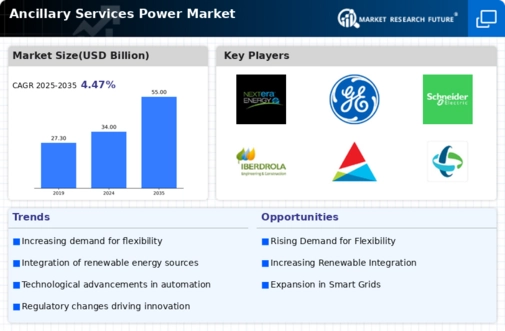Top Industry Leaders in the Ancillary Services Power Market

*Disclaimer: List of key companies in no particular order
Top listed global companies in the Ancillary Services Power industry are:
General Electric Company
Siemens AG
ABB Ltd.
Schneider Electric SE
Enel S.p.A.
Duke Energy Corporation
Dominion Energy, Inc.
NextEra Energy, Inc.
EDF Energy
BP p.l.c.
Total SE
Bridging the Gap by Exploring the Competitive Landscape of the Ancillary Services Power Top Players
The power grid, once a static network of centralized generation and linear transmission, is undergoing a dramatic transformation. The rise of renewables, distributed generation, and smart grid technologies is pushing the boundaries of grid stability and reliability, placing increased emphasis on ancillary services. These behind-the-scenes heroes play a crucial role in maintaining grid frequency, voltage, and power quality, ensuring the smooth flow of electricity to consumers. Consequently, the ancillary services power market is witnessing a surge in activity, attracting a diverse range of players with distinct strategies and ambitions.
Key Player Strategies:
- Traditional Powerhouses: Established power generation and utility companies leverage their existing infrastructure and grid knowledge to offer ancillary services. They often focus on frequency regulation and reserves, capitalizing on their large, flexible generation assets. Companies like Siemens, ABB, and General Electric are prominent examples, providing comprehensive solutions for grid stabilization.
- Independent Service Providers (ISPs): Nimble and innovative, ISPs specialize in specific ancillary services, such as voltage control, reactive power management, and energy storage integration. They bring cutting-edge technologies and business models to the market, often targeting niche segments or offering flexible solutions at competitive prices. AES, NextEra Energy, and Engie are notable players in this space.
- Technology Disruptors: New entrants, armed with digital and data-driven solutions, are blurring the lines between traditional players. Energy storage companies like Tesla and Fluence are rapidly expanding their offerings, providing fast-responding energy reserves and grid support services. Additionally, software and analytics companies are developing tools for grid optimization and predictive maintenance, enhancing the efficiency and effectiveness of ancillary services.
Factors for Market Share Analysis:
- Technology Leadership: Companies with advanced technologies, such as fast-responding energy storage systems, intelligent grid management platforms, and AI-powered prediction tools, are likely to gain an edge.
- Geographical Reach: Players with a strong presence in key markets, particularly those with high renewable energy penetration and ambitious grid modernization plans, will have a competitive advantage.
- Regulatory Landscape: Navigating the evolving regulatory frameworks for ancillary services is crucial. Companies that adapt quickly and capitalize on new market opportunities will thrive.
- Cost-Effectiveness: Delivering reliable and efficient ancillary services at competitive prices is key to attracting and retaining customers. Optimizing operations and leveraging economies of scale will be essential for success.
- Partnerships and Collaborations: Building strategic partnerships with complementary players, such as renewable energy developers, grid operators, and technology providers, can unlock new opportunities and enhance capabilities.
New and Emerging Trends:
- Focus on Renewables: Integrating renewables seamlessly into the grid requires innovative ancillary services solutions. Companies are developing technologies for frequency regulation with variable generation sources and managing the intermittency of wind and solar power.
- Market Design Innovations: New market mechanisms, such as capacity markets and pay-for-performance models, are emerging to incentivize investment in ancillary services and ensure grid stability with increased renewable energy penetration.
- Decentralization and Distributed Energy Resources: The rise of distributed energy resources like rooftop solar and microgrids is creating new opportunities for localized ancillary services provision. Companies are developing solutions for grid edge management and peer-to-peer energy trading to optimize grid operation at the local level.
- Digitalization and Automation: The increasing use of digital technologies, such as cloud computing, big data analytics, and artificial intelligence, is transforming the way ancillary services are delivered. Smart grid technologies are enabling real-time monitoring, predictive maintenance, and automated response systems, enhancing grid resilience and efficiency.
Overall Competitive Scenario:
The ancillary services power market is characterized by intense competition, with established players, agile ISPs, and technology disruptors vying for market share. The landscape is constantly evolving, driven by technological advancements, regulatory changes, and the increasing integration of renewables. Companies that can adapt to these changes, embrace new technologies, and develop innovative solutions will be well-positioned to thrive in this dynamic and growing market. Building strong partnerships, focusing on cost-effectiveness, and delivering reliable and efficient services will be key to success in this crucial sector of the energy industry.
Latest Company Updates:
General Electric Company (GE):
- Date: October 26, 2023
- Development: GE announced a partnership with AES to develop a next-generation grid stabilization platform using AI and advanced forecasting, targeting improved frequency regulation and grid resilience. (Source: GE press release)
Siemens AG:
- Date: December 12, 2023
- Development: Siemens launched its "Grid Edge Solutions" portfolio, offering integrated battery storage, microgrid, and energy management solutions for distributed energy resources and grid modernization. (Source: Siemens press release)
ABB Ltd.
- Date: November 15, 2023
- Development: ABB secured a contract to provide a turnkey microgrid solution with battery storage for a remote island community, highlighting its focus on island electrification and off-grid applications. (Source: ABB press release)

